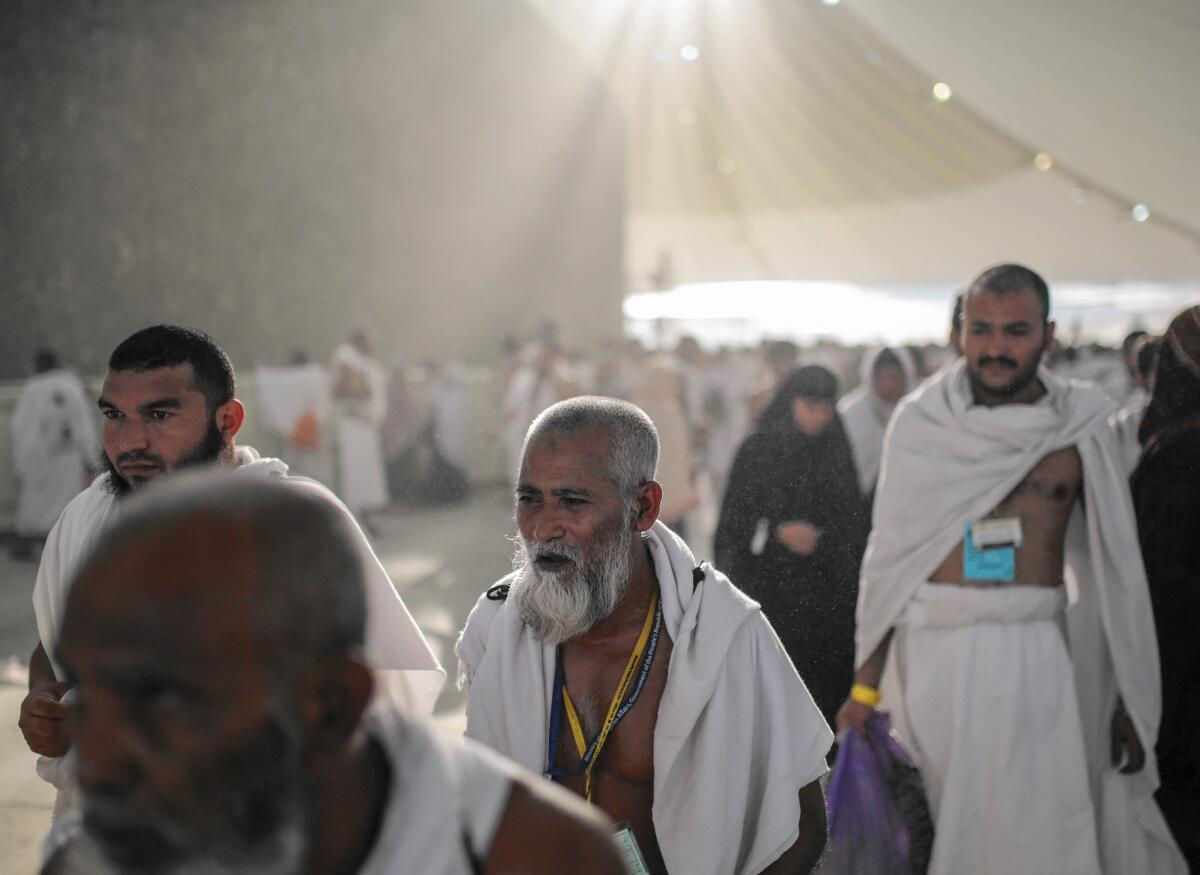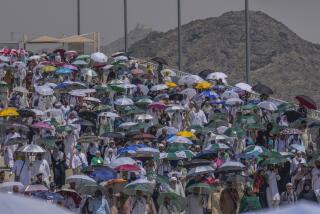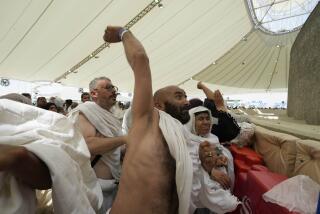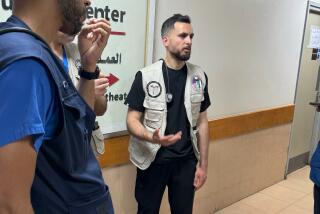Stoning the devil and other highlights of a Fullerton pilgrim’s hajj, the journey of a lifetime

Reporting from Mecca, Saudi Arabia — The plane was filled with the chants of the faithful. Labayk Allahuma labayk. Over and over for the entire short flight from Medina to Mecca, the chants rang out. Labayk Allahuma labayk. I am here for you, Allah, I am here for you.
We were headed to Mecca, to the Kaaba, Islam’s holiest site. We were pilgrims headed to hajj five years ago, my parents, my younger sister and I. As I sat in the crowded plane, I thought, “I wish I had a tape recorder.” It was stirring to feel that joint commitment to God. I could not help crying.
Hajj is a once-in-a-lifetime requirement for all Muslims who are physically able and can afford the taxing and pricey journey. My parents, who were 69 when we traveled together to Mecca in 2010, had already made the pilgrimage. But for my sister and me, it was a new experience, one we had longed for.
We weren’t prepared for the crowds. The hajj is a journey with enormous throngs, countless people pressed against each other as they approach holy sites. It is a spiritual journey but also a perilous physical experience.
Before you embark on the pilgrimage, you must ask forgiveness from anyone you have offended. My brother and I had not spoken for a long time. So I spoke with him on the phone and asked for forgiveness for the distance between us.
Also in preparation, your debts must be paid, and you have to have a will in case you die on the trip. There is always a chance — one that the pilgrims who died during the crush in this year’s hajj knowingly took. You have to enter ihram, a pure state of mind and dress. Men are not supposed to wear stitched clothing. They usually wear a white piece of cloth around the waist. Women wear a white abaya, or long cloak, and a white hijab covering their hair.
Oftentimes, Muslims are buried in the clothes they wear for hajj. I expect I will be buried in mine.
But that first day of the five-day pilgrimage, we had no time to change. We arrived in Mecca shortly before dawn, in time for Fajr, the first prayer of the day.
When we got there, we couldn’t get in. There were just too many people.
Photographs of hajj show the throngs of pilgrims, but nothing can prepare you for the real thing. Lights control entrance to the Grand Mosque. If it’s green when you arrive, you can go in and begin the seven circuits of the Kaaba, the black, cube-shaped structure at the center of the mosque.
Muslims believe the house of worship was built by Adam and reconstructed by Abraham and his son Ishmael. There’s a huge sense of history tying back to the first person on Earth.
But we got a red light when we arrived. It was a disappointment. You come all this way and you want to get to the Kaaba. The first prayer I did in Mecca was outside the mall that neighbors the Grand Mosque. I could see the Kentucky Fried Chicken. I prayed that morning with mixed feelings. I’m so close, I thought, and there’s the KFC.
The first time we got into the Grand Mosque, my first umrah, I was compelled to touch the Kaaba. It’s not a requirement or an important part of the pilgrimage, but I just had to touch it. I cannot explain how strong the magnetism was.
As the four of us got in tighter and tighter in the circuits, people were so close, their elbows were in your chest, they’re stepping on your feet. Everyone has tunnel vision. I had my arm hooked into my mom’s. But she thought it was too oppressive so close to the Kaaba, so she and my sister and dad pulled back.
I took a couple of circuits by myself. You have to be pushy to jab your way in. Some of the men don’t want the women to get closer. That’s sexism, not Islam. Someone behind me grabbed my hijab to get some leverage and almost pulled it off my head.
Within a couple of minutes I was able to reach out and touch the eastern wall of the Kaaba. I felt a huge sense of relief. I walked along and touched it in a few more places before I pulled away and could pray. I didn’t find my family again until the end of the day.
Muslims pray five times a day, each time facing toward the Kaaba, no matter where they are in the world. In most mosques you’re segregated by sex. But in Mecca, in the Grand Mosque, when it comes time to pray, you pray. If you’re next to a bunch of men, you pray by a bunch of men. And it was a little weird for me.
Because you’re in this state of ihram, some people don’t use deodorant. You’re out in the sun. They sweat. They start smelling. I thought it would be liberating to pray next to a guy. I’ve never done that before. But I was put off by it. Women don’t smell this bad.
In another part of hajj, Muslims throw stones at pillars symbolic of the devil. That ritual happens in Mina, where more than 700 people were killed in a stampede Thursday.
My trip was crowded as well, as thousands of pilgrims threw pebbles, seven at a time, to demonstrate their rejection of evil.
I found myself thinking that non-Muslims would probably see the jamarah ritual as primitive. Who cares? I was again living a part of Islamic tradition, and frankly, a fun one. I loved looking at my itinerary on those days and thinking, “On today’s agenda: Stoning the devil.”
It is believed a prayer made in Mecca, the cradle of Islam, has more value than in, say, Fullerton, where I live. At the Prophet’s Mosque in Medina, a prayer is worth 10,000 times more. At the Grand Mosque, it’s 100,000 times more.
Because of the people all around during hajj, it’s hard to narrow it down to you and God. On the flip side, I had never felt that much of a connection with so many people in my life. Hajj made me feel a part of the Muslim community, the ummah, in a way I never had before.
Times staff writer Maria L. La Ganga contributed to this report.
More to Read
Sign up for Essential California
The most important California stories and recommendations in your inbox every morning.
You may occasionally receive promotional content from the Los Angeles Times.










